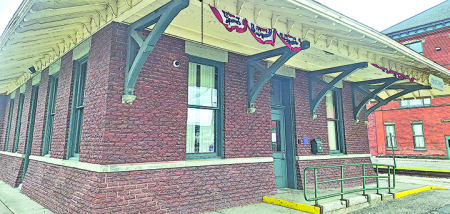Week 12: Grand Lake To Rock Springs
Published:
September 11th, 2006
By:
Bryan Snyder
My foot reflexively slammed on the brakes, bringing the Jeep to a halt in the middle of a dusty Wyoming road as a herd of twenty pronghorn antelope burst out from behind a sagebrush ridge. They dashed across the road and continued bounding up the hill to my right – a bewildering flurry of brown and white shapes, dizzying to look upon. The four feet of each antelope struck the earth at the same time, launching them forward as if their hooves were made of rubber. It was the most graceful display of panic and paranoia I’d ever seen.
I find myself captivated by the way nature seems to… bounce. The pronghorns pinged and ricocheted off the ground, similar to the energetic tumbling of pebbles down a steep gully. This image came to mind because I had accidentally created such a rain of stones while climbing Colorado’s Cascade Mountain three days earlier. Near the summit, a buttress of rotten rock gave way beneath my legs, and I clung to the mountainside for support as the material fell into the gully below. The rock splintered and fragmented along its descent, spawning a thousand pebbles which bounced merrily from wall to wall of the ravine.
It was the most dangerous moment in an otherwise uneventful twenty-five-mile ridgeline traverse, but I nonetheless found myself fascinated by the movement of the falling stones. The walls of the gully seemed to act like pinball machine bumpers, giving extra energy to the pebbles, and in the same way, the ground beneath the hooves of the antelope seemed to be pushing back as the creatures leapt up the hillside, providing an added strength to their leap that seemed illogical and almost magical.
So many examples of bouncing in the natural world made themselves apparent this week. The woodpecker, gliding away from a tree, flicks open its wings and bounces off the air like a skipping stone. The thunder of the afternoon storm bounces from mountainside to mountainside. And there was definitely a bounce in the step of the sheepherder dog I passed this morning. He had taken an unauthorized break from his herding duties and was bringing a large jackrabbit back to his cowboy master. The rabbit’s enormous ears and legs hung from the dog’s mouth and dragged across the ground, but the dog pranced happily and effortlessly despite his burden and the mixed response he was likely to receive from his supervisor.
Myself, I feel most joyful and alive when I’m bounding down a mountain trail, springing from rock to rock. I can sometimes feel the ground giving me an extra lift as I bounce along, which is the closest I’ll ever get as a human to true flight. But when I’m backpacking, carrying my tent, stove, food and all the other necessary gear, it is hard to bounce. Even a spring in my step is difficult to manifest. So I only venture into the backcountry when I feel especially motivated, such as this week when I sought to climb the remote Kings Peak - the highest mountain in the state of Utah.
Midway through the 35-mile journey, I made camp at timberline and waded through a thicket of willows so I could reach a stream and wash off the day’s sweat. Rushing water bounced off a protruding rock and was propelled into the air like a fountain; I caught some in an aluminum pot to use for boiling rice. Overhead, a swarm of two-tailed mayflies performed a dance, bouncing up and down as if tied to the strings of yo-yos.
The next morning I ascended 13,528-foot Kings Peak and surveyed the land. The Uinta Mountains have a unique geography, as if some divine architect tried to carve a chunk of southern Utah’s red sandstone into a semblance of the Rocky Mountains. The landscape looked like it would prefer to form canyons and mesas, but ice and snow have a way of sculpting mountains into a generic form. The result appeared to look something like the Rocky Mountains after a hunger strike, with skinnier peaks and broader valleys.
I dropped down into the cradle of one of these red-walled valleys and saw the potential for a picturesque campsite once I reached Henrys Fork Lake. But as I negotiated the forested shoreline I heard the snapping of branches and was deeply startled by the emergence of a massive bull moose, just twenty-five feet away. It looked appraisingly me at me with its huge black eyes, and I tried singing just to ward off any perceived tension.
Thankfully, the beast moved on and began munching on willows, but its position blocked access to a peninsula of dry land that rose above the lake and adjacent marshes. I desired to have this promontory as a campsite, so with some boldness I snuck around the moose and gained the higher ground. The view of the water was just what I wanted for my final night in the wilderness, but before I could fetch my pack, a second bull moose descended from the hills and joined his friend on the neck of the peninsula. It was going to be an interesting evening.
Moose antlers flare up from their heads like the wings of a butterfly, yet ironically they lumber around with as much grace as a blindfolded buffalo. I guess when you weigh over half a ton, you don’t have to worry about being impeded by physical obstacles. There isn’t much of the “bouncing” motif evident in the movements of moose, but perhaps there’s something to be said for lumbering, too. After all, it was lumbering with a backpack, not bouncing, which gave me the chance to witness all of this: the wildlife, the striped redrock mountains, and the aspen leaves changing quickly to gold. Now if I could just bounce my way over these two feeding creatures and reach my backpack, maybe I could enjoy a meal of my own!
Bryan is a 1991 Norwich High School graduate and works as a naturalist at the Rancho Alegre Outdoor School in Santa Barbara, Calif. You may reach him mid-journey at foolsby@hotmail.com.
Author: Bryan Snyder - More From This Author
Comments










